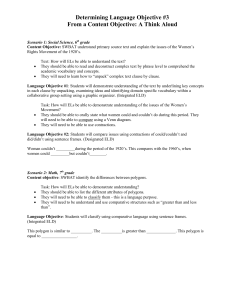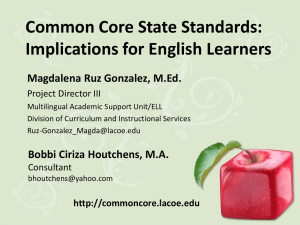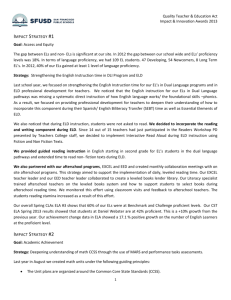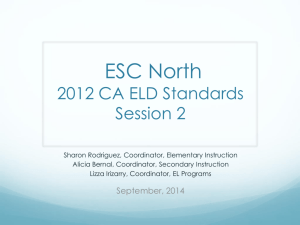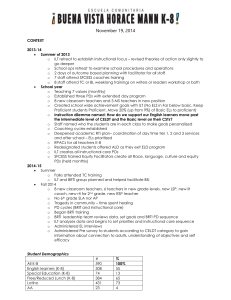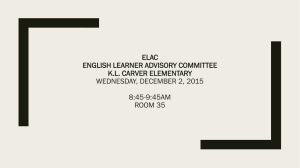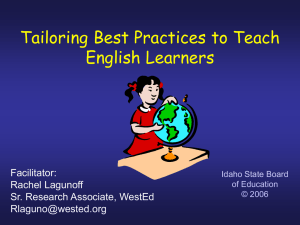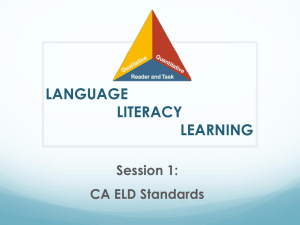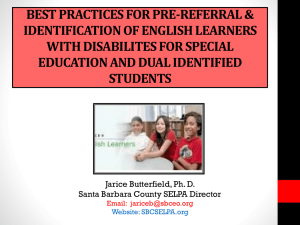CA ELD Standards Session 4
advertisement
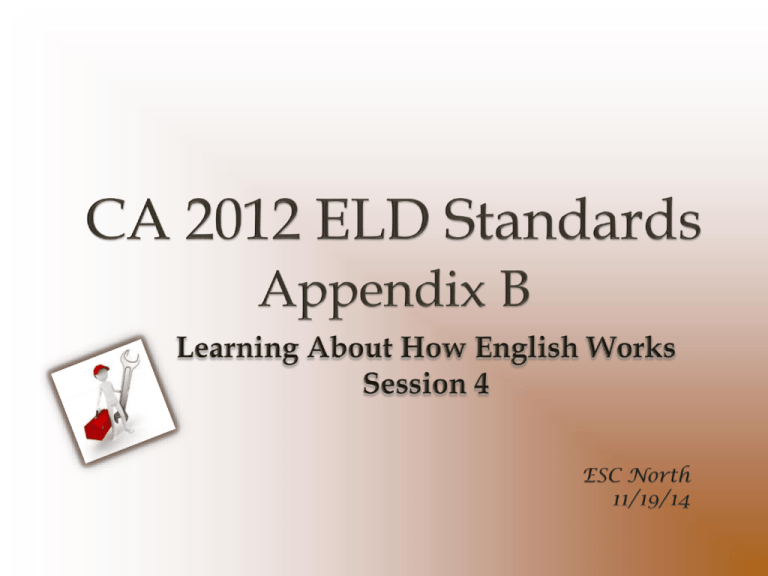
ELD Transition Sessions Session 1: ELD Standards Introduction Shifts, Layout, & Development Session 2: Proficiency Levels Session 3: Appendix C Theory that Informs Layout Session 4: Appendix B Learning About How English Works Phase-In Plan for 2012 ELD Standards 2014-2015 2015-2016 •Transition •Implementation Objective • Develop an understanding of Appendix B: CA ELD Standards Part II: Learning About How English Works District Instructional Priorities Common Core (The What) Master Plan (The Who) TGDC Teaching & Learning Framework (The How) Guiding Principles 1. English Learners (ELs) are held to the same high expectations of learning established for all students. 2. ELs develop full receptive and productive proficiencies in English in the domains of listening, speaking, reading & writing. 3. ELs are taught challenging academic content that enables them to meet performance standards in all content areas. 4. ELs receive instruction that builds on their previous education and cognitive abilities and that reflects their language proficiency levels. 5. ELs are evaluated with appropriate and valid assessments that are aligned to state and local standards and that take into account the language development stages & cultural backgrounds of the students. 6. The academic success of ELs is a responsibility shared by all educators, the family and the community. English Learner Master Plan, 2012 Pages 2-3 What must students be able to do with language? ELA MATH SCIENCE Comprehend and evaluate complex texts across a range of types and disciplines Understand and use stated assumptions, definitions, and previously established results in constructing arguments Construct explanations and designated solutions Construct effective arguments and convey intricate or multifaceted information Make conjectures and build a logical progression of statements to explore the truth of their conjectures Discern a speaker’s key points Justify their conclusions, communicate them to others, and respond to the arguments of others Engaging in argument from evidence Obtain, evaluate, and communicate information CA ELD Standards AMPLIFY the CCSS for ELA/Literacy Request clarification and ask relevant questions Build on others’ ideas Articulate their own ideas, and confirm they have been understood 2012 CA ELD Standards Part I: Interacting in Meaningful Ways Part II: Learning About How English Works Part III: Foundational Skills The Autobiography of Malcolm X “I became increasingly frustrated at not being able to express what I wanted to convey in letters that I wrote,... In the street, I had been the most articulate hustler out there - I commanded attention when I said something. But now, trying to write simple English, I not only wasn’t articulate, I wasn't even functional…” Academic Language and its Connection to Catalyzing Comprehension Through Discussion and Debate SERP: Strategic Education Research Partnership Whole Text Sentence Level (Clauses, phrases, nominalization) Appendix B Learning About How English Works 1. Read page 1, first 2 paragraphs 2. What connections did you make to Paola’s explanation of academic English? 3. Share Out Interpretive Mode Appendix B Learning About How English Works Number off from 1 – 4 1. Read your assigned section 2. Highlight key phrases and or statements Reading Sections 1. 2. Text Level Understanding Pages 6 – 9 Skim p. 8 Sentence and Clause Level Understanding 3. Phrase Level Understandings 4. Page 9 – 12 Page 13 – 14 Word Level Understandings Pages 14 -15 Appendix B Learning About How English Works 1. Read your assigned section 2. Highlight key phrases and or statements Interpretive Mode Group Work 1. Form Experts Groups 1s, 2s, 3s, 4s 2. Analyze phrases/statements Collaborative and Interpretive Modes Summary Create a Summary What are the salient points of your reading Share Out Productive Collaborative Whole Text Sentence Level (Clauses, phrases, nominalization) Academic English Before Now Academic Writing Page 8 Reflection 1. How will I begin to plan lessons that develop the understanding of academic English for my ELs? TEACHER RESPONSIBILITY “I do it” Focus Lesson “We do it” Guided Instruction Collaborative “You do it together” “You do it alone” Independent STUDENT RESPONSIBILITY A Structure for Instruction that Works Doug Fisher “As students learn more about the patterns of English grammar in different communicative contexts…, they can develop more complex understandings of English grammar and usage. Students can use this understanding to make more purposeful and effective choices in their writing and speaking and more accurate and rich interpretations in their reading and listening.” Appendix B, page 4
